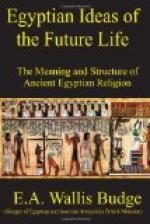[Footnote: See Rosweyde, Vitae Patrum,
p. 59; Life of St. Anthony, by Athanusius (Migne),
Patrologiae, Scr. Graec, tom. 26, col.
972.] The spread of this idea gave the art of mummifying
its death-blow, and though from innate conservatism,
and the love of having the actual bodies of their
beloved dead near them, the Egyptians continued for
a time to preserve their dead as before, yet little
by little the reasons for mummifying were forgotten,
the knowledge of the art died out, the funeral ceremonies
were curtailed, the prayers became a dead letter,
and the custom of making mummies became obsolete.
With the death of the art died also the belief in
and the worship of Osiris, who from being the god
of the dead became a dead god, and to the Christians
of Egypt, at least, his place was filled by Christ,
“the firstfruits of them that slept,”
Whose resurrection and power to grant eternal life
were at that time being preached throughout most of
the known world. In Osiris the Christian Egyptians
found the prototype of Christ, and in the pictures
and statues of Isis suckling her son Horus, they perceived
the prototypes of the Virgin Mary and her Child.
Never did Christianity find elsewhere in the world
a people whose minds were so thoroughly well prepared
to receive its doctrines as the Egyptians.
This chapter may be fittingly ended by a few extracts from, the Songs of Isis and Nephthys, which were sung in the Temple of Amen-R[=a] at Thebes by two priestesses who personified the two goddesses. [Footnote 1: See my Hieratic Papyrus of Nesi-Amsu (Archaeologia, vol. III)]
“Hail, thou lord of the underworld, thou Bull of those who are therein, thou Image of R[=a]-Harmachis, thou Babe of beautiful appearance, come thou to us in peace. Thou didst repel thy disasters, thou didst drive away evil hap; Lord, come to us in peace. O Un-nefer, lord of food, thou chief, thou who art of terrible majesty, thou God, president of the gods, when thou dost inundate the land [all] things are engendered. Thou art gentler than the gods. The emanations of thy body make the dead and the living to live, O thou lord of food, thou prince of green herbs, thou mighty lord, thou staff of life, thou giver of offerings to the gods, and of sepulchral meals to the blessed dead. Thy soul flieth after R[=a], thou shinest at dawn, thou settest at twilight, thou risest every day; thou shalt rise on the left hand of Atmu for ever and ever. Thou art the glorious one, the vicar of R[=a]; the company of the gods cometh to thee invoking thy face, the flame whereof reacheth unto thine enemies. We rejoice when thou gatherest together thy bones, and when thou hast made whole thy body daily. Anubis cometh to thee, and the two sisters (i.e., Isis and Nephthys) come to thee. They have obtained beautiful things for thee, and they gather together thy limbs for thee, and they seek to put together the mutilated members of thy body. Wipe thou the impurities which




